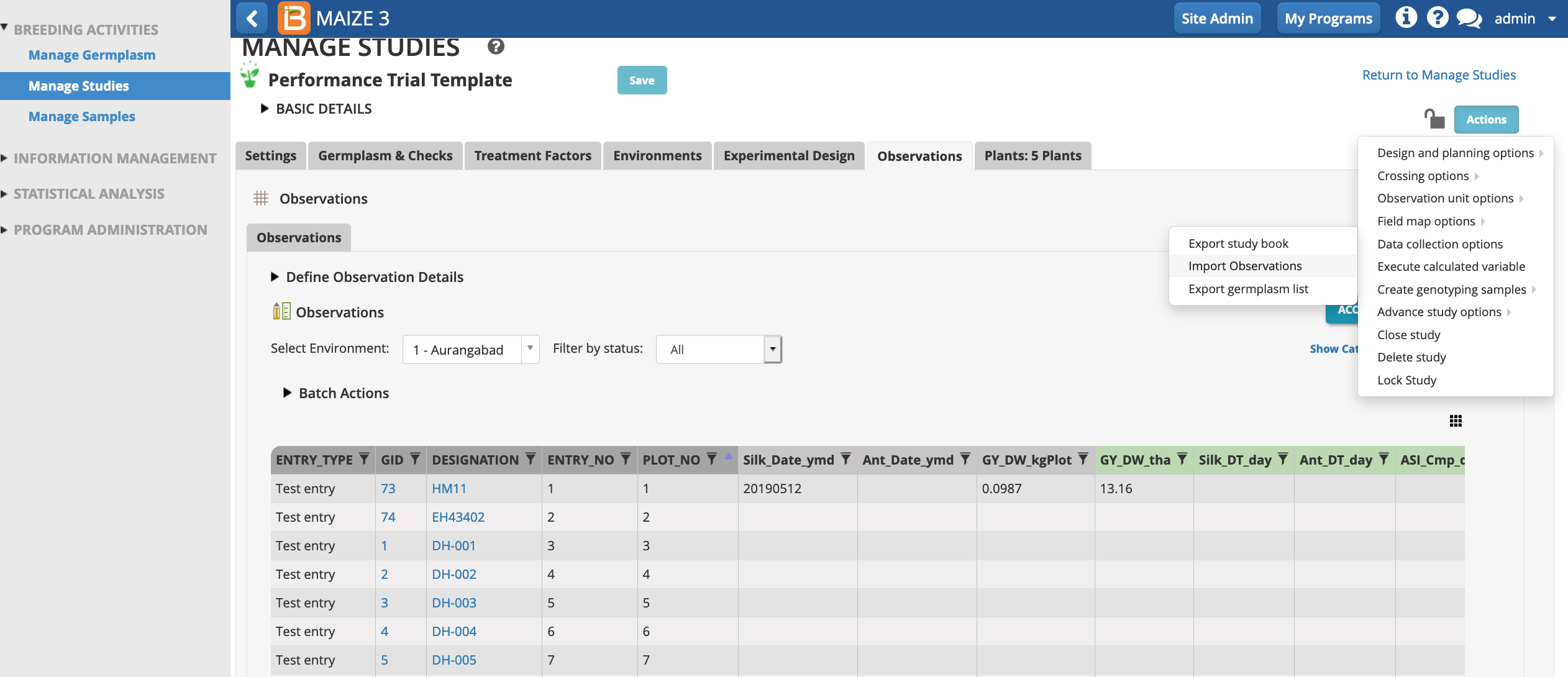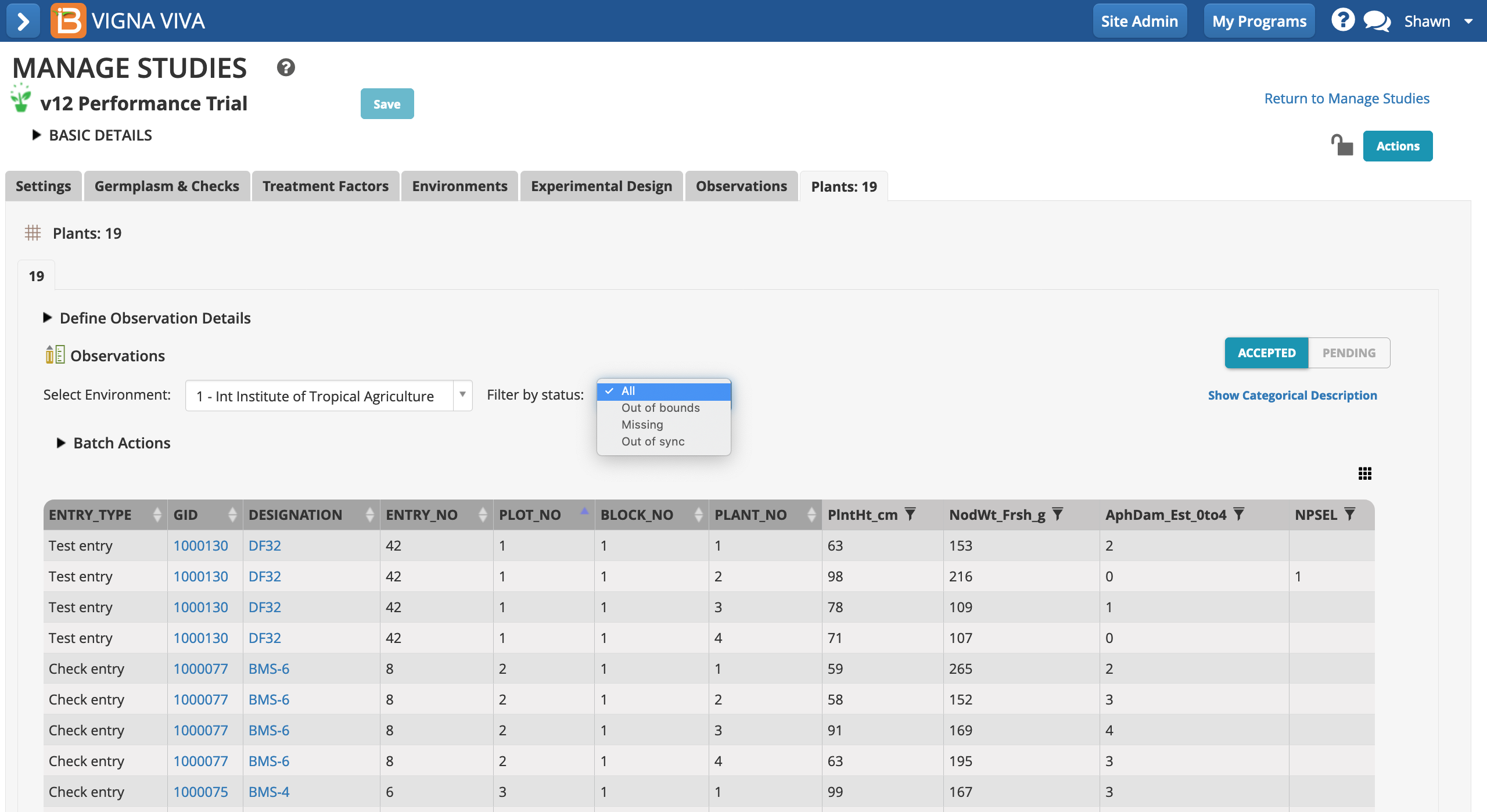About
Once you have a dataset established you can start collecting data for your study. Datasets can be loaded/downloaded from studies in 3 different ways.
- Inline editing
- Study Book file export and import
- BMS connection to BrAPI enabled applications*
*The Breeding Management System is plug-and-play compatible with BrAPI enabled applications. However each of these applications is different and developed independently of the Integrated Breeding Platform. If you are interested in using BrAPI enabled applications, please see the developer's user documentation for more information.
Inline Edits
You can modify trait observations by directly clicking on them and typing.
-
Click on a cell that you want to modify and edit. Once you leave the cell, the edit is automatically accepted to the database.

File Export/Import
The BMS allows you to export/import the Study Book in spreadsheet format (.xls,.csv).
- Click on Actions>Data Collection Options>Export study book to download the study book file. Then select the study instances that you want to consider for download.

Green column headers indicate calculated variables that the BMS can dervive from formulas and inputs.
- If your study has more than one dataset, choose the appropriate one and Continue.

File Format
Observation, or plot-level, datasets have several export format options. Sub-observation data sets only offer .csv format - expect expanded options for sub-observations datasets in upcoming releases. Note: If you export more than one instance at a time you'll get a .zip file containing on excel/csv per instance.
- CSV: This format is compatible with a variety of applications
- Excel: This format is compatible with the DIB handheld data capture application.
- Fieldbook KSU: Format compatible with the KSU fieldbook data capture application (.csv & .xls)
- Select the export format and the data collection order. Serpentine data collection order is available after a field map has been created (see more Make Field Map).

The exported file is ready for data entry or for label printing using external applications, like Excel or Bartender.

Notice that the study book file includes OBS_UNIT_ID - a unique observation id suitable for barcode labeling of individual observations. The studybook also includes empty columns of data for calculated variables. You have the option to load pre-calculated data or to leave blank and let the BMS perform the calculation.
Record Observations
Record observations and save file.

Observations have added to the columns corresponding to raw data traits. The calculated traits are left empty for BMS calulations later.
Import
- Click on Actions>Data Collection Options>Import Observations to browse for the file to upload

- Select the appropriate dataset. Continue.

- Select file type and specify file. Import.

Pending Data
Pending view flags out of bound data and reveals if data will be over written. Data staging in pending view allows the Breeding Management System to accept data without overwriting existing data. Data staging provides an important quality control step, especially now that the system can except data automatically via BrAPI from external applications, like digital scales and handheld data capture apps.
- At this point you can review the imported data. If there is a problem, you can Accept or Discard the whole dataset or manually modify the problematic values (see below).

Notice that entry 1 has two cells of data pending overwrite, Silk_Dat_ymd & GY_DW_kgPlot. The data to be overwritten is within parenthesese.
Review & Validate
If the value for a given trait variable exceeds the expected range defined in the ontology (see Manage Ontology), the BMS will flag these values in red. You are not able to save the data until the out-of-bounds values have been validated, corrected or accepted.
- Review out-of-bounds data from the Actions Menu under Data Collection Options.

Out-of-bounds values for the aleurone color scale (1-5) are highlighted red and are preventing the data from being saved.
- Choose how to proceed with out-of-bounds data.
- Review Details
- Accept all data as-is
- Set all exceptions to missing
- Review details and select Next to navigate out-of-bound values and make individual decisions about them.

- Review the details of out-of-bounds data. Enter revised values, accept the out of range values, or set the data to missing. Set all exceptions to missing will designate out-of-bounds as "missing". Finish.

Aleurone color (scale 1-5) has three out-of-bounds values. Plot number one was given a revised value of 1 and the other two plots are set to missing.
Accept data
- Select Accept to commit the pending data to the database.

- Accepting data as-is will not change the out-of-bounds values. Accepted out-of-bounds values are highlighted a light blue color.

Inline Validation
- Perform inline decisions with out of bound data by editing a given cell. Either enter new value or right click to accept or exclude.
Data Staging
When you import sub-observation data, these data are staged in pending view.
Pending
Pending data is NOT available in the database for queries and analysis. Pending data must be either accepted for long-term storage or discarded. The filtering and batch action functionalities are still under development. Expect improvements in upcoming versions.
- Import observations. Select Accept or Discard.

- If the pending data contains values that fall outside of the min/max range defined by the ontology, choose to accept the data as is or to set all exceptions to "missing". If accepted as-is, you have the opportunity later to review and edit these values. Proceed to accept the data.

Accepted
Accepted data is in long-term database storage and available for QC as well as queries and analysis. The filtering and batch action functionalities are still under development. Expect improvements in upcoming versions.

Data for 3 traits (plant height, nodule weight, and aphid damage score) and number of plants selected have been accepted into the database.
Import Data After Acceptance
Once data has been accepted it can be overwritten or additional data added via data import. In the following example, a breeder has accepted data, but notices an error in the measurement of nodule fresh weight in the originating spreadsheet. She is able to correct the spreadsheet and import the file again.
- Review the pending data. Select Accept or Discard.

The BMS only displays new data in pending view. Although the file uploaded also contained plant height and selections, these data are not shown in pending view because they match the already accepted data. Only nodule fresh weight needs to be reviewed in pending view. Notice that the first nodule fresh weight measurement of 153g will be replaced with 15.3g once if the pending data is accepted.


